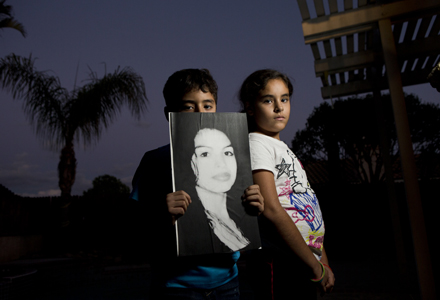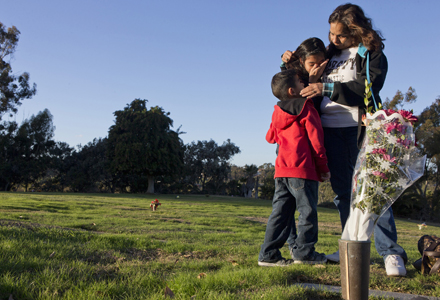Critics say federal agents often lack training for domestic police work
By Rob O’Dell and Bob Ortega
On the afternoon of March 15, 2011, at least five Border Patrol agents and another federal agent went with Sierra Vista police officers to conduct a “knock and talk” at a house in a neighborhood where police suspected a human-smuggling operation.
After agents knocked on the front screen door, a white Chevy Suburban smashed out through the garage door, rammed into law-enforcement vehicles and drove at officers, according to Sierra Vista police reports.
Federal agents fired 10 shots at the vehicle, and Sierra Vista officers fired once, with several bullets hitting the vehicle. The drivers escaped, and the Suburban was later found on a mountain in nearby Fort Huachuca.
No one was hurt, but neighbors hid during the shooting, and a stray bullet struck a nearby Hyundai Santa Fe and was later found in the back seat, the police report said.
The incident is one of an increasing number of cases nationwide in which Border Patrol agents back up local police or perform other police duties, such as serving warrants or responding to domestic disputes, even though critics say they aren’t adequately trained to do so.
Other incidents have turned deadly. Five of the 24 people killed by the Border Patrol since 2010 were killed by agents who were backing up local police or helping to serve arrest warrants, an investigation by The Arizona Republic has found.
At least four of the nine Americans killed by the Border Patrol since 2010 died in these incidents, The Republic found. Three deaths occurred along the northern border with Canada — two in Maine and one in Washington.
Some of the shootings were deemed justified by investigators, although in four cases, family members dispute details of Border Patrol accounts.
From Maine to California, the Border Patrol has responded dozens of times to back up local law enforcement in the past four years, incident reports reviewed by The Republic show.
But Border Patrol agents receive substantially less training than police officers and are not required to undertake additional training to respond to incidents with local police.
A report released by the Department of Homeland Security’s Office of Inspector General in September found that many Border Patrol agents don’t understand their own policies on when to use force.
The report also said trainees who leave the Border Patrol Academy “are not fully prepared for possible real-life situations they might encounter.”
“Border Patrol agents are not adequately trained to solve problems with words,” said Josiah Heyman, a professor of anthropology at the University of Texas-El Paso who has studied the border for 30 years. “They don’t have these everyday police skills.”
Critics are also concerned that having the Border Patrol team up with local police opens the door for warrantless searches and immigration checks, a violation of the Fourth Amendment right against unreasonable search and seizure.
As the number of Border Patrol agents has risen, so has the number of reports of agents backing up local police. From 2005 to 2012, the number of agents nearly doubled to more than 21,000.
During its hiring surge, the Border Patrol scaled back training and relaxed requirements — such as not requiring a high-school diploma. It sometimes skipped background checks, leading to problems with corruption and poorly trained agents.
Even more agents could be on the way. One immigration-reform proposal would put 20,000 additional agents on the ground. If it were adopted, there likely would be more instances of Border Patrol backing up local police because there would be more agents to respond to requests, said Shawn Moran, vice president of the National Border Patrol Council, the union for Border Patrol agents.
Moran said the primary reason the agency backs up local police is that Border Patrol agents want backup from local police if they need it. “We need to know the help will be there when our agents get into a difficult situation,” he said.
In an interview, acting Deputy Commissioner of Customs and Border Protection Kevin McAleenan said, “Backing up other law-enforcement agencies is part of the job, it’s part of our responsibility.”
Plainclothes Border Patrol agents were preparing to serve an administrative warrant for an undocumented immigrant at an apartment in Chula Vista, Calif., south of San Diego, in September 2012.

Nine-year-old twins Isaac and Rebecca Alvarado with an image of the their mother, Valeria Tachiquin-Alvarado, who was shot and killed Sept. 28, 2012, by a border agent in Chula Vista, Calif. (Nick Oza /The Republic)
Valeria Tachiquin-Alvarado, a U.S. citizen, was at the apartment, which was thought to be a drug den. She left after the agents served the warrant, which did not result in an arrest.
Agents tried to stop her as she entered her car. Agents alleged that she hit one or more of them with her car as she pulled out trying to leave. One of them tried to pull the car keys out of the ignition, according to media reports.
As she drove away, Border Patrol Agent Justin Tackett either jumped or was forced onto the hood of her Honda Accord.
It traveled about 200 yards with him on the hood, police and Border Patrol accounts said. Tackett, fearing for his life, fired 10 shots into the windshield from the hood of the car, killing Tachiquin-Alvarado, a 32-year-old mother of five.
However, the lawsuit alleges that Tackett fired the fatal shots while standing upright, walking toward the car as Tachiquin-Alvarado was reversing it away from him. The San Diego coroner said she tested positive for methamphetamine at the time of her death. She was on parole for a previous drug conviction.
The family has filed a wrongful-death suit against Tackett and the Border Patrol, claiming that Tackett was unfit for hire by the Border Patrol. The suit said he had been disciplined and resigned as he was about to be fired from a prior post with the Imperial County Sheriff’s Office for “multiple acts of serious misconduct and ethical violations.” He sued to get his job back at the Sheriff’s Department and lost, the suit states.
The lawsuit alleges that Tackett was suspended four times as a sheriff’s deputy for misconduct. He was about to be fired in 2004 for two incidents: In the first, he unlawfully searched a property without a warrant and “negligently” left a man handcuffed in a hot patrol car with the windows closed. In the second, he improperly searched a hotel room after a traffic stop.
The charges in the second case were rejected because the prosecutor said Tackett’s Fourth Amendment violations were “almost too numerous” to list, the lawsuit said.
Tackett worked for then-U.S. Rep. Duncan Hunter for two years before being hired by the Border Patrol. Hunter, who ran for president in 2008 on a border-security platform, could not be reached for comment.

Annabell Gomez visits the burial site of her daughter, Valeria Tachiquin-Alvardo, on Dec. 4, 2013, with two of her grandchildren Analya Alvarado, 11, and Israel Alvarado, 6. (Nick Oza /The Republic)
Tachiquin-Alvarado’s family said she died needlessly.
Tachiquin-Alvarado’s mother, Annabell Gomez, said she wants the agent and Border Patrol to explain why her daughter was shot. “I wish it would stop, they’d stop killing people and hurting people,” she said. “Who are they to have that authority? They aren’t no God.”
Her attorney, Eugene Iredale, said the administrative warrant for the undocumented immigrant did not allow for the plainclothes agents to detain Tachiquin-Alvarado. He said he believes the agents served the warrant in the hopes of finding drugs and either make a drug case or find informants for drug cases.
Tackett’s attorney, Richard Tolles, called the incident a “highly justified shooting” and said a response to the lawsuit will be filed this week. “This is a compelling case of self-defense,” Tolles said.
Moran, of the Border Patrol union, said that agents can serve administrative warrants as part of their job, adding that some intelligence units use them more often than other agents.
“It’s specifically in our authority,” Moran said.
He said Tackett was struck by the car and was justified in his use of deadly force, contending that if he had not, “we may have had a dead agent on our hands.”
“The agent feared for his life and had no other way to to stop the vehicle,” Moran said. “The agent had no choice but to use his firearm.”
Border Patrol agents often deal with situations by simply making commands and generally don’t have the skills or training to negotiate these complex situations, such as armed standoffs or dealing with mentally ill suspects, said Heyman, of the University of Texas-El Paso.
Manuel Rodriguez, police chief of National City, Calif., south of San Diego, said police officers get more training than Border Patrol agents, and they do so in an urban environment rather than the rural environment the Border Patrol works in.
The training is also far longer for local officers. The National City academy is six months. Several of the police academies in the Phoenix area are 18 to 20 weeks in length.
The Border Patrol says its agents receive 58 days of academy training.
Rodriguez said his police officers practice the concept of contact and cover — where one officer contacts and interacts with the subject and the other covers him or her — but sometimes, the Border Patrol doesn’t practice this basic concept.
Moran said Border Patrol agents might not have specific training for local incidents, but he said he feels that agents “have a very good grasp” of law-enforcement training and principles. In all five cases, Moran said, it seemed that Border Patrol agents were justified in using deadly force.
“Overall, they are very well-trained and equipped to respond to a vast majority of the incidents they might encounter,” Moran said.
Border Patrol agents responding with local police raises an additional concern — that Fourth Amendment rights against illegal search and seizure could be violated because of the difference in the missions of the Border Patrol and the police.
Border Patrol agents can’t enter a house without a warrant, but agents responding to incidents with local police often check the immigration status of those whom they encounter on the call, Heyman said. This means they are arresting people whom they would not have been able to without responding to the local police calls.
“The Border Patrol use it as a measure, as a way, to arrest people they encounter in the process,” he said.
This is leading to immigrant communities near the border not wanting to call the police because they know they will bring the Border Patrol with them, Heyman said.
The Border Patrol has expanded search-and-seizure powers, said James Lyall, a staff attorney with the American Civil Liberties Union of Arizona.
Those include being allowed to enter onto private property within 25 miles of the border, using warrantless search powers to stop vehicles or vessels within 100 miles of the border, and interrogating any “alien or person believed to be an alien” anywhere in the country, according to U.S. Code.
Some Border Patrol agents may be willing to exceed the scope of their expanded powers, Lyall said. And with the Border Patrol growing, so is collaboration with local law enforcement and civil-rights complaints, Lyall said. “It is a major problem,” Lyall said. “It is essentially undermining the Fourth Amendment.”

